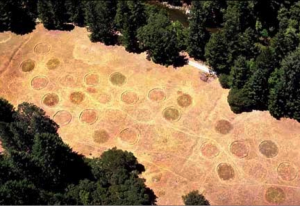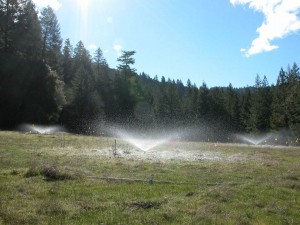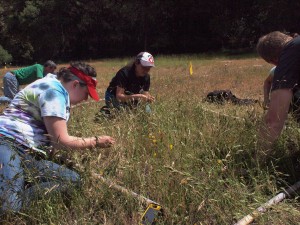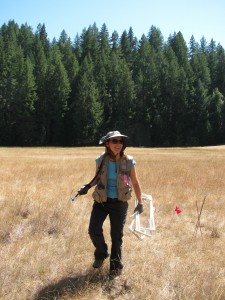Impacts of European and native grasses on meadow arthropods
Kirsten Hill studies how invasive annual versus native perennial grasses affect the interactions of spiders and herbivorous insects in meadow food webs. Angelo meadows, which occur along flat river terraces flanking the Eel River, are habitat islands in a sea of forest. These meadows contain vibrant populations of native perennial California grasses and forbs, but are also invaded to various degrees by European annual grasses and weeds. Kirsten hypothesized that the perennial bunch grasses would keep microclimates cool and moist late into the summer, prolonging periods when spiders could grow and feed on grasshoppers, including potential pest species. In contrast, annual grasses die back by mid-summer, leaving hot, barren areas too harsh for spiders, but favorable for warm-adapted grasshoppers. Kirsten has used enclosure experiments, surveys, and meticulous natural history observations to uncover the impacts that dominance of native versus invasive grasses (and grassland restoration) could have on meadow arthropods, and how these arthropods in turn affect meadow flora, including wild flowers. Kirsten Hill is a former Ph.D. from Environmental Science, Policy, and Management at UCB.
Systems biology of the soil microbiome (“Microbes Persist”)

The “Microbes Persist” Soil Microbiome project is a DOE-funded Science Focus Area (SFA) led by Lawrence Livermore National Lab Senior Staff Scientist Jennifer Pett-Ridge.

Microorganisms play key roles in soil carbon turnover and stabilization of persistent organic matter via their metabolic activities, biochemistry, and extracellular products. Microbial residues are the primary ingredients in soil organic matter (SOM), a carbon pool that is critical to Earth’s soil health. The Soil SFA is investigating how microbial cellular-chemistry, functional potential, and ecophysiology fundamentally shape soil carbon persistence. Project members are characterizing this via stable isotope probing (SIP) of genome-resolved metagenomes from soils at three California grassland sites located in Hopland, CA (from Hopland Research and Extension Center) the Angelo Reserve, and Sedgwick Reserve. The SFA focuses on soil moisture as a ‘master controller’ of microbial activity and mortality, since altered precipitation regimes are predicted across the temperate U.S.The ultimate goal of the project is to determine how microbial soil ecophysiology, population dynamics, and microbe-mineral-organic matter interactions regulate the persistence of microbial residues under changing moisture regimes.
Direct and indirect responses of meadow species/systems to altered rainfall in California grassland

In a large field experiment that has been running continuously since 2001, Blake Suttle and his students and collaborators have studied direct and indirect effects of altered rainfall regimes in meadow food webs and ecosystems. Blake rigged a clever underground sprinkler system to alter the intensity or duration of the annual rainfall in large,  replicated experimental plots. Every year, twelve 70-m2 plots of open grassland are subjected to rainfall changes predicted by the Hadley 2000 climate model for the California North Coast (doubled precipitation during the winter (January-March)). Twelve more plots receive rainfall as predicted under the leading Canadian climate model (double the amount of rain falling later in spring (April-June)). A third group of twelve control plots receive ambient rain. Changes in seasonal water availability had pronounced effects on individual grass, forb, and arthropod species, but as precipitation regimes were sustained across years, feedbacks and species interactions overrode individual physiological responses, and produced patterns opposite to what would have been predicted from the physiological ecology of perennial (native) versus annual (exotic) grasses. Conditions that sharply increased production and diversity through the first 2 years reversed, and caused
replicated experimental plots. Every year, twelve 70-m2 plots of open grassland are subjected to rainfall changes predicted by the Hadley 2000 climate model for the California North Coast (doubled precipitation during the winter (January-March)). Twelve more plots receive rainfall as predicted under the leading Canadian climate model (double the amount of rain falling later in spring (April-June)). A third group of twelve control plots receive ambient rain. Changes in seasonal water availability had pronounced effects on individual grass, forb, and arthropod species, but as precipitation regimes were sustained across years, feedbacks and species interactions overrode individual physiological responses, and produced patterns opposite to what would have been predicted from the physiological ecology of perennial (native) versus annual (exotic) grasses. Conditions that sharply increased production and diversity through the first 2 years reversed, and caused
simplification of the food web and deep reductions in consumer abundance after 5 years. Changes in these natural grassland communities suggest a prominent role for species interactions in ecosystem response to climate change.
Long-term research on simulated climate change in meadow ecosystems

 A 2005 Berkeley Ph.D., Meredith Thomsen has continued her research at the Angelo as a Professor in the Biology Department at the University of Wisconsin-La Crosse. Since 2006, she has made annual trips with students and UW-L colleague Tim Gerber to help sample the rainfall addition project started by Blake Suttle in 2001. Student participants are a mix of Biology majors and Biology Education majors. All students gain first-hand research experience, and, with Tim’s guidance, the Biology Education majors prepare lesson plans based on the research which align with national science standards. Research experience for future teachers broadens the societal impact of our work, as those students become teachers and share the experience in their K-12 classrooms.
A 2005 Berkeley Ph.D., Meredith Thomsen has continued her research at the Angelo as a Professor in the Biology Department at the University of Wisconsin-La Crosse. Since 2006, she has made annual trips with students and UW-L colleague Tim Gerber to help sample the rainfall addition project started by Blake Suttle in 2001. Student participants are a mix of Biology majors and Biology Education majors. All students gain first-hand research experience, and, with Tim’s guidance, the Biology Education majors prepare lesson plans based on the research which align with national science standards. Research experience for future teachers broadens the societal impact of our work, as those students become teachers and share the experience in their K-12 classrooms.
